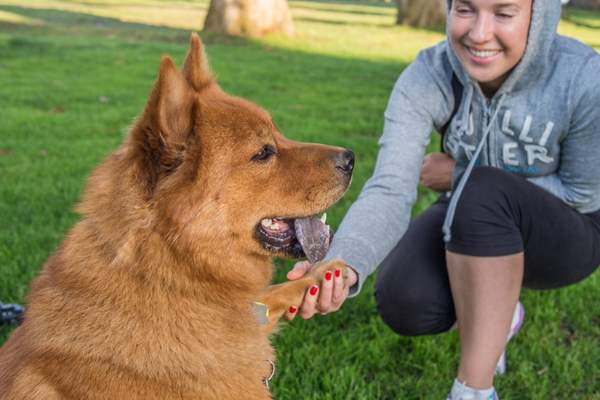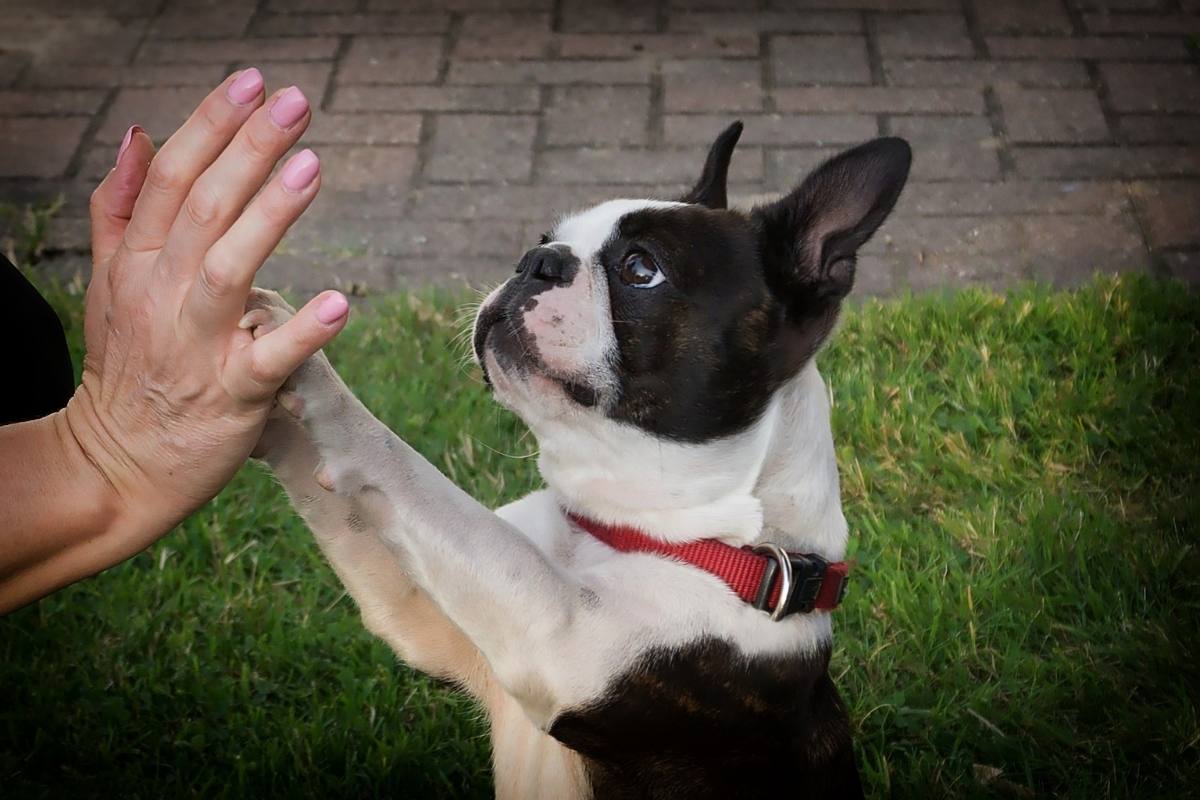You and your dog are likely good friends. He trusts you to take care of him day to day and give him lots of love, you trust him to be a good boy and a great companion through thick and thin. However, there is one thing in particular that your dog doesn’t trust you with at all, and that is his feet. Reaching for his paws makes him jumpy and anxious, even though you mean no harm to him—so what gives?
So, why does my dog jump when I touch his paws? The answer lies in our own feet, as dogs, just like us, have a multitude of nerve endings in their feet, and so they are worried about having their paws handled, even by people they’re familiar with.
Reading more about how your dog’s paw function and sensitivity, and what to look for if there’s trouble will help you ensure that your dog is happy and comfortable even when getting their feet handled or their nails trimmed.
Sensitive Soles

If you have ever had to walk barefoot over a surface like concrete, you’ll know that though your own feet have calluses that protect you, they do have limits. Abrasion and wear will eventually begin to hurt, and you’ll be in pain. Your dog has feet that are both tough and tender, just like us.
Most canines are capable of running on tough terrain, digging holes through hard dirt, and withstanding both hot and cold surfaces—but they do have limits, just like we do. The more physically active your dog is on a variety of surfaces, the more resilient your dog’s paws will become, but this doesn’t mean that they can’t feel anything.
Even if you have thick calluses, you’re still capable of feeling intense temperatures, pressure, and pain through your feet, which is why you wear shoes. Dogs are very much the same way. You may have even seen images of working dogs wearing boots that protect their feet from both hot pavement and frozen ground.
These things exist because dogs’ pads are surprisingly sensitive, and they require protection and care just like ours do. This sensitivity is part of the reason why your dog doesn’t like having their feet touched: your hand on their foot feels strange, and they’re concerned it will hurt.
Nail Trimming
It may be hard for you to see your dog scared of you touching their feet, or even concerning if your dog becomes aggressive when you reach for their paws—however, it’s a necessary evil, as all dogs need their nails trimmed regularly, and combining a gentle examination of the foot with the nail trim is a great practice of preventative care.
Of course, you can take your dog to a groomer to have their nails trimmed, but that’s not always an option, and can be even more stressful for your dog. Training your dog to be tolerant of having their feet touched is important for both your and your dog’s health and safety.
Following these steps patiently and consistently is a slow, but surefire way of helping your dog be better about having their feet touched.
– First, bring out the clippers. Your dog either doesn’t know what they are, or already knows and thinks they’re scary. If you have a dog who runs away from the clippers, try to avoid cornering them or pressuring them too much, but do make an effort to let your dog give the clippers a sniff to start reassuring your pet that the clippers are not going to hurt them.
Most importantly, DO NOT trim their nails yet. This is just exposure therapy, not a pedicure!
– Next, start working with your dog to show them that having their feet held or touched is not going to hurt them, either. Start by sitting with your dog and giving them a shoulder scratch, then pet their leg, then touch their paw, trying to give each toe a gentle squeeze.
This might take some time, depending on your dog’s overall attitude toward their feet, but with persistence and patience, your pet will stop being so reactive. Reward calm behavior with treats and praise.
– Third, combine the clippers with the ‘foot massage’. Work up to holding your dog’s foot, then, when you have their foot in one hand, pick up the clippers and squeeze them as you squeeze one toe. This will help your dog get used to the sound of the clippers, and to the sensation of having their feet handled at the same time. Again, rewards are a great way to help training progress faster.
– Now that your dog is comfortable, you can finally try trimming your dog’s toenails. When trimming your dog’s nails, it is extremely important to start small. Do NOT go all the way to the base of their nail, as you will end up cutting through the nerves and living tissue of the nail’s quick; instead, trim just the tip of the nail, keeping the cut parallel with the bottom of your dog’s foot.
Keeping the cut ‘flat’ to the floor will ensure that the nail will continue to grow correctly.
– Above all, if your dog yelps and/or the nail starts to bleed, stop the trim immediately and treat the cut with styptic powder. Styptic powder is a fast-acting coagulant that will stop the bleeding and reduce pain so that the nail trim can continue safely.
Just like trimming your own nails too short causes discomfort, the same goes for dogs. Accidents happen but reducing the chance by only taking a little bit of nail at a time is always a good idea.
– Lastly, give your dog with little treats throughout the trim and at the end of the trim. Every time you repeat this process, and your dog is rewarded for good behavior, it reinforces good habits and makes nail trims easier.
Tenderness from Exercise

You and your dog may be workout buddies—and this is a great thing, particularly if you have a high-energy breed on your hands. However, your dog, just like you, can get sore and sensitive if pushed too hard too fast.
If your dog used to be fine with having their feet touched and has suddenly become sensitive to it, is suddenly limping, or appears reluctant to run with you, your dog could have painful feet or cracked pads. Try giving your dog’s feet a gentle examination, and if you notice dry, cracked pads or obvious increased sensitivity, it’s time for some rest for your pet.
A paw moisturizer, not human moisturizer, and a gentle massage could help your dog recover faster and get back into action sooner, but it’s important to remember that your dog may be struggling with your workout, so taking things a little easier is a good idea. However, if the soreness doesn’t resolve itself on its own, it’s time to speak to your local vet.
Other Causes of Sensitivity
Dogs’ feet come into contact with all sorts of things outdoors, infections and injuries are not uncommon. If your pet seems suddenly uncomfortable in regard to the their feet, do a gentle check of their paw pads, their nails, and in between their toes to see if you spot anything out of the ordinary, like a stuck pebble, a cut or bruise, a broken nail, or just general redness or irritation.
If you spot any obvious injuries to their pads, see your dog limping or licking their feet obsessively, or notice any unusual discharge or blood on their feet, it’s best to get your dog to the vet as soon as you can for a check-up.
Bacterial, parasitic, or fungal infections are common and easily treated with medication, and though lacerations can be more serious, the vet will be able to take care of them. Keeping an eye out for any strange behavior from your dog is always a good idea, as it will often prevent a minor problem from becoming a serious one.
Your vet will know what the best course of action is for your dog, and your pet will soon be back on its feet, good as new.
Conclusion
In many ways, dogs are better equipped for the great outdoors than we are, as their feet and claws are tough and durable. However, despite their overall durability, paws are also very sensitive, and operate just like our own feet do.
Healthy paws not only help your dog grip, run, and dig, they also convey important sensory information about the terrain underfoot, and keep your dog well-balanced. This sensitivity is a huge part of why your dog is so anxious about things like having their nails trimmed, because ultimately your pet is unfamiliar with the sensation, and is concerned that you’ll accidentally hurt them.
It might seem easier to just let your dog’s feet be, but because of paws’ importance, proper foot care is essential to a happy, healthy, and comfortable dog.
Therefore, it’s important to train your dog to be open to having their feet handled, With patience, kindness, and an abundance of treats, your dog will eventually learn that nail trims are not nearly as scary as they seem, and both you and your pet will be much happier about the whole event.

